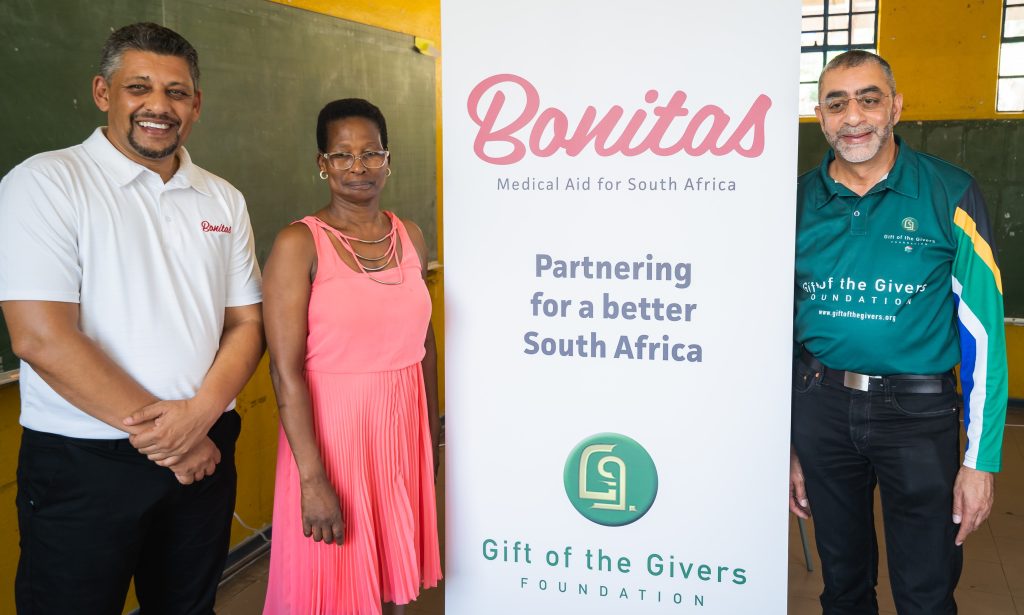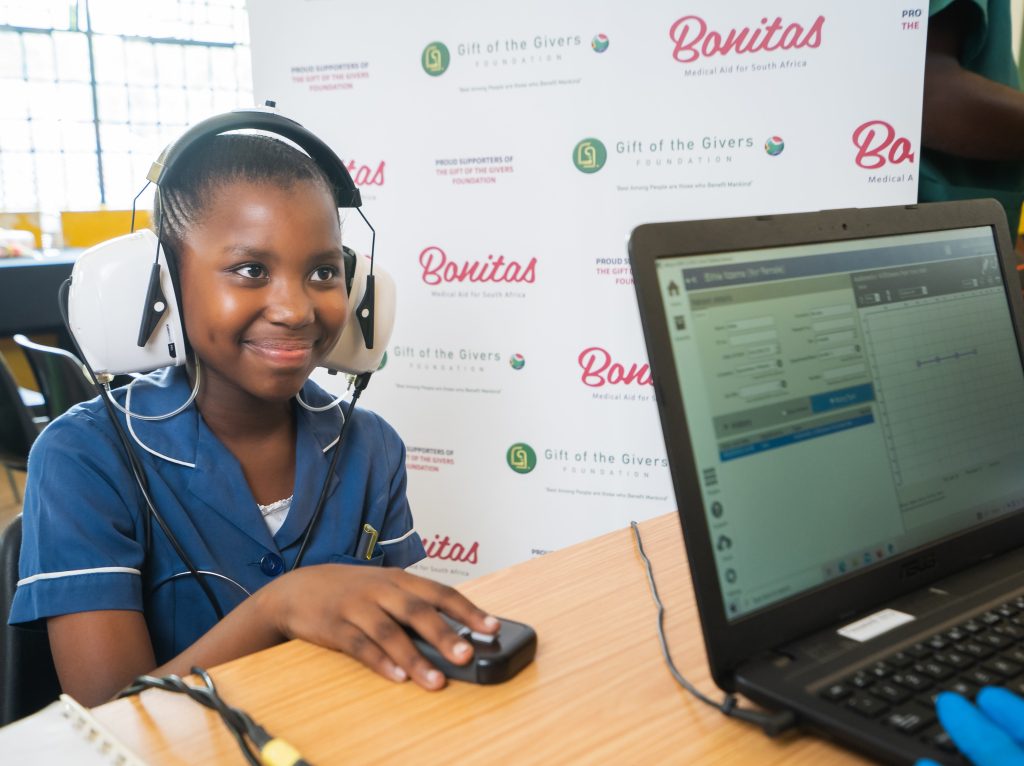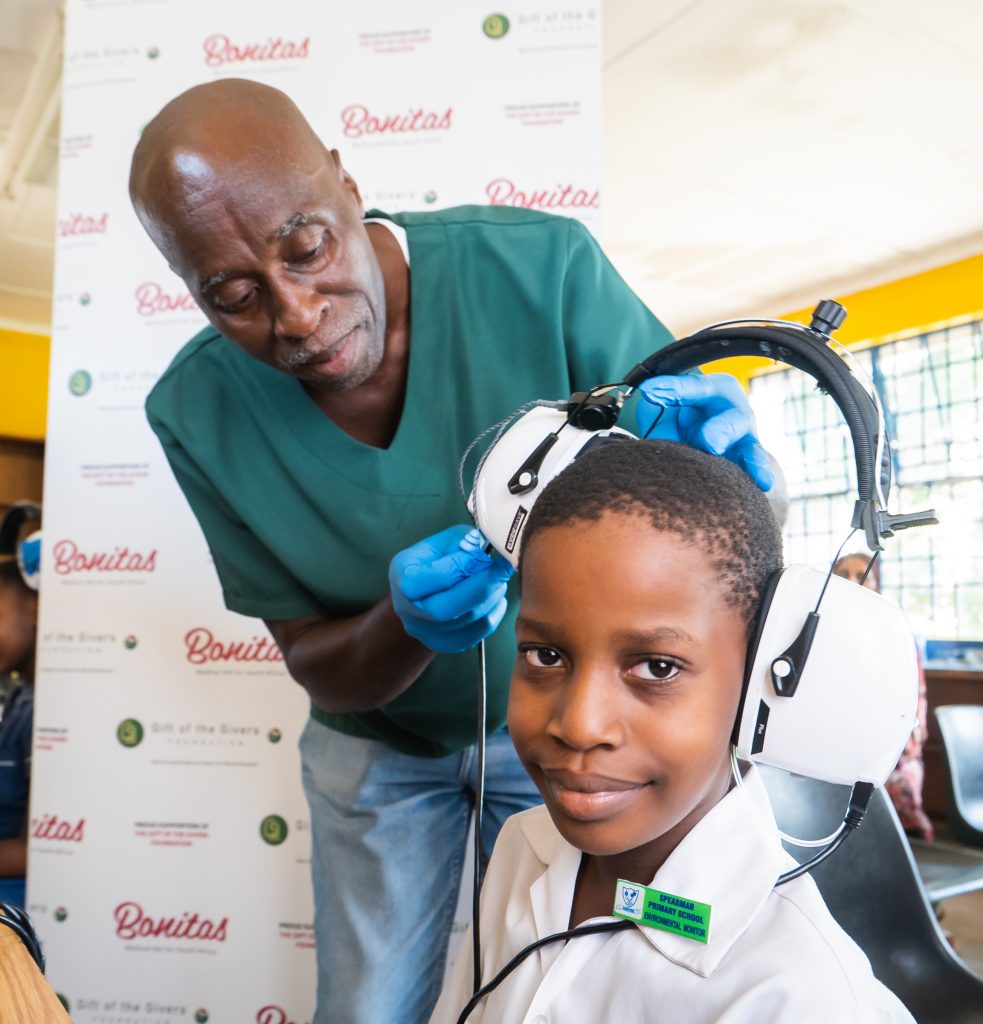Q & A
The Bonitas/Gift of the Givers Audiology Project has allowed the audiology team to identify and assist even more learners with possible hearing problems.

Number of learners tested to date: 1 225 learners at four schools during term 1 of 2023, many of whom received treatment where necessary. (Since the start of the audiology project in 2019 a total of 13 727 learners have been tested)
Number of learners identified with a hearing loss/ear pathology: 19 (180 in total)
Number of wax removals done: 334 (1 807 in total)
Follow up steps have been taken with both these groups of learners

Part of The Gift of the Giver’s audiology intervention includes a follow up with parents and learners to ensure that they have received the necessary treatment. Each learner is given a referral form which they give to their parent/caregiver. The referral form has recommendations that the parent will need to follow through.
Based on the learner’s diagnosis the recommendations will require them to either visit a GP/ENT specialist/Audiologist for further assessment and management. In some cases, we will also refer to a Speech Therapist or Occupational Therapist. The families are required to visit the recommended professionals at their nearest hospital or clinic. The Gift of the Givers Audiology team then make telephonic follow ups with the families in the following 2-3 weeks, to see if the recommendations have been followed through with.
How prevalent is hearing loss in South African school children?
Hearing loss is more common than we think, up to 19% of South African school children suffer from varying degrees of hearing difficulties.
Learners are meant to be screened from birth to 3 months with intervention taking place by 6 months of age (JCIH, 2019). However, in the South African context this does not take place due to the lack of resources as well as the lack of awareness regarding hearing loss signs and symptoms, leaving many children undiagnosed, or their hearing loss going unnoticed. Hence the Gift of the Givers audiology programme allows us to bridge this gap by allowing for early detection, identification, referrals and management of children with hearing loss or ear pathologies.
The number of primary school children globally who have some form of hearing impairment as a comparison.

Over 5% of the world’s population – or 430 million people – require rehabilitation to address their disabling hearing loss (432 million adults and 34 million children). It is estimated that by 2050 over 700 million people – or 1 in every 10 people – will have disabling hearing loss. ‘Disabling’ hearing loss refers to hearing loss greater than 35 decibels (dB) in the better hearing ear. Nearly 80% of people with disabling hearing loss live in low- and middle-income countries. The prevalence of hearing loss increases with age, among those older than 60 years, over 25% are affected by disabling hearing loss.
In South Africa, it is estimated nationally that the prevalence of hearing impairment is four to six in every 1 000 live births in the public health care sector (Swanepoel, Storbeck & Friedland, 2009). (See reference links below)
According to the South African National Deaf Association (SANDA), children should have their hearing tested several times throughout their schooling: When they enter school, at ages 6, 8 and 10 and at least once during Grades 8 or 9 and Grades 10 and 12.
Why is this necessary, what changes could happen between these tests and what causes it?
According to the Health Professionals Council of South Africa (HPCSA) Minimum Standards for School Hearing Screening Policy (developed by the Professional Board for Speech, Language and Hearing Professions) : All school aged learners should be afforded access to hearing screening services once during each of the four educational phases (Foundation phase – Gr R-3; Intermediate phase – Gr 4-6; Senior phase – Gr 7-9; and Further Education and Training – Gr 10-12) (ISHP, 2012). Screening should also be offered to learners (HPCSA, 2018)
- At risk for academic failure or who are repeating a grade
- Parent/teacher concerns regarding hearing, speech, language or learning ability
- Previous or ongoing ear pathology
- WHO request hearing screening (self-referral). The importance of screening learners at these different stages is to account for any unaddressed hearing problems that could have occurred during the child’s schooling career. Some hearing losses may be acquired, for example:
- A child may have experienced an injury/trauma to their ear which may have affected their hearing.
- A learner may have developed recurrent ear infections, which if left untreated could result in a hearing loss.
- A learner may also have a delayed onset of hearing loss.
- Some illnesses can result in hearing loss e.g TB, meningitis.
- In some cases, learners are lost to follow ups ie. Learners who are previously identified, the families may not have gone through with the follow up process.
The Gift of the Givers Audiology Programme therefore takes this into account and assesses learners at both primary and secondary school level (Grade R till Grade 12).
Are there any case studies or short explanation of success stories directly as a result the Gift of the Givers audiology project?
Yes, many learners who were identified with hearing loss, whose parents/guardians followed through with the recommendations, were seen for further assessment and management at their hospitals and are now fitted with hearing aids. Learners who also presented with ear infections were seen by the GP/ENT to assist with treatment and management.
A recent case from the previous high school, there was a learner who was lost to the follow up process/mismanagement of her case. She was previously diagnosed at a hospital with a hearing loss when she was younger and her family was told that she needed hearing aids. The family was not informed when to come in for the hearing aids and no further follow ups were done over the years. When we assessed the learner, we also found she had a problem with the mobility of her jaw and mouth which was affecting her speech ability as well as her ability to eat. The learner was referred to an audiologist, speech therapist as well as a dentist for further evaluation and management. We are in the process of doing a follow up on the case and will be keeping track of the progress made.
Has the Kuduwave machine proved to be effective?
Yes, it has. It’s portable and incorporates the audiometer and audiology booth into one, which makes it easy to conduct school screenings. It not only allows for screening but can also be used for diagnostic evaluations. We have also been using the device at primary schools, with younger age groups, and it has proven to be quite effective.
Anything of importance about this project to add?
We were recently able to purchase the Otodynamics Otoport screening device which we are really excited about. This device is an OAE (Otoacoustic emission) and ABR (Auditory Brainstem Response) Screener and will now be added to the Gift of the Givers Audiology test battery. It can assess the function of the cochlear and auditory nerve. It is an objective test which does not require any response from the patient, as compared with the pure tone audiometry (PTA) screening, which is a subjective test. This will allow us to now test learners who are unable to complete the conventional audiometry testing. For example:
- A younger child who may struggle to understand the test procedure during PTA screening and are unable to complete the test. Therefore, we will now be able to do more testing for a younger age group of children, e.g. pre-school.
- Allow us to test Special Needs learners who may have difficulty completing PTA screening.
- It will also allow us to either rule out or confirm the presence of a hearing loss in learners whose results were unreliable or inconsistent.
Reference links:
http://www.scielo.org.za/scielo.php?script=sci_arttext&pid=S2225-47652019000100004
For 2025 we have a renewed Female Health Programme:In collaboration with CareWorks, it’s accessible to all female members aged 18 and above, with an emphasis on preventative care and early detection of female-specific health issues. In addition, we have an enhanced Maternity Programme to support expecting mothers. This includes early identification of and weekly engagement for high-risk pregnancies, post-childbirth care and associated mental health follow-up calls for new mums, given the prevalence of pre and postnatal depression. Also, milestone reminders for children under 3 and cover for antenatal vitamins through savings, day-to-day benefits or the Benefit Booster
Bonitas Medical Fund
0860 002 108
View Website: www.bonitas.co.za
- Breastfeeding tips - December 15, 2025
- Mental health matters during the festive season: Let’s normalise getting help - December 11, 2025
- Neonatal jaundice, what is it and what happens if my baby is born with it? - December 8, 2025





